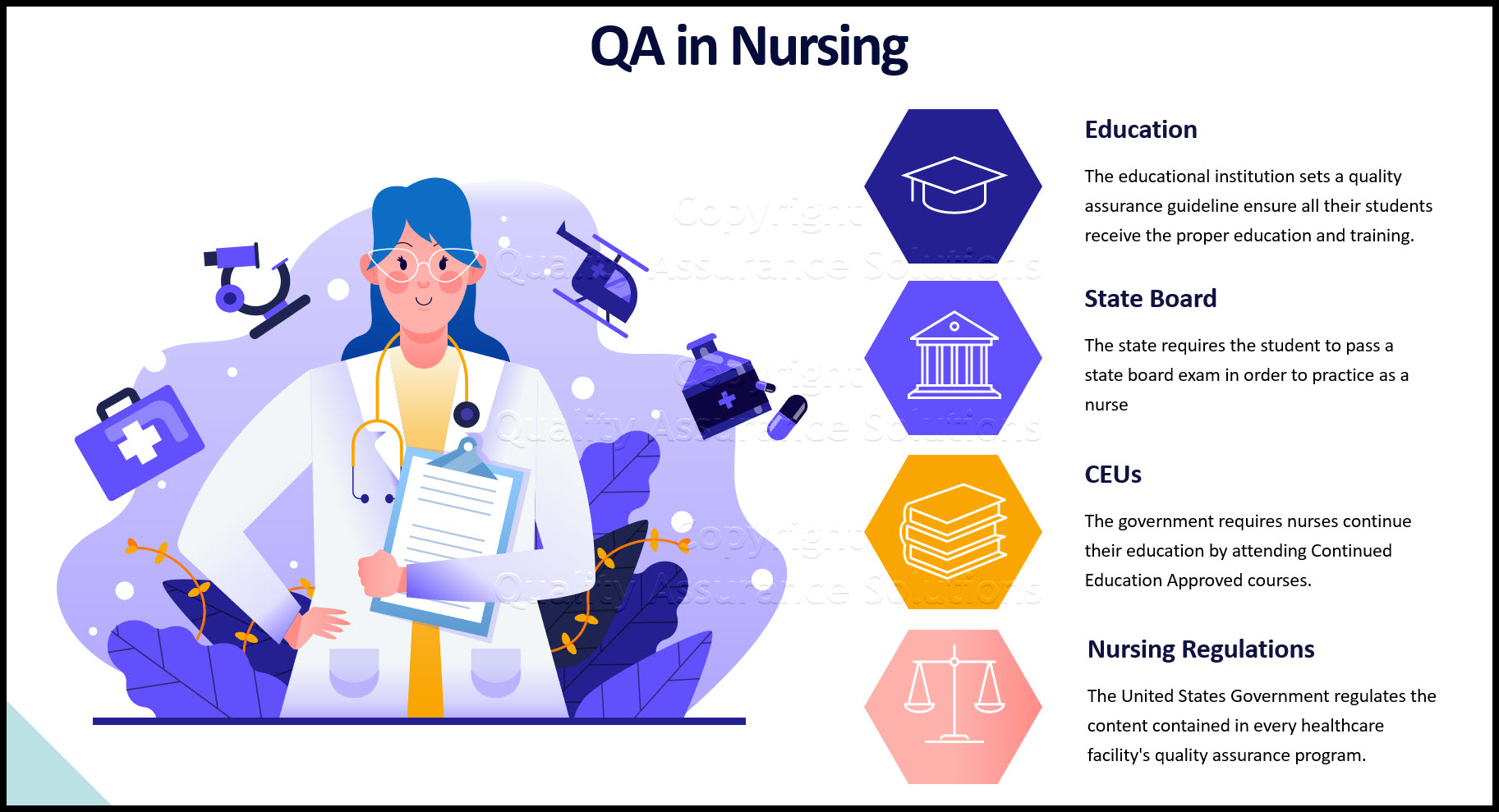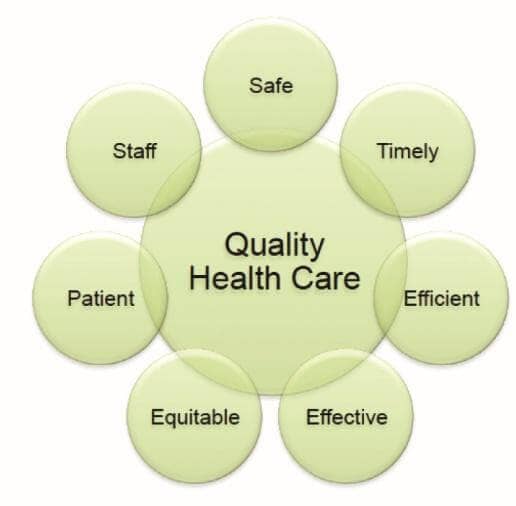Quality Assurance in Healthcare refers to the systematic activities and procedures to ensure care excellence. It encompasses the continuous improvement of healthcare services.
Ensuring that patients receive the highest standard of care, quality assurance in healthcare is a pivotal concern. It involves the implementation of various policies, protocols, and practices designed to bolster the safety, effectiveness, and reliability of healthcare delivery. Healthcare providers engage in ongoing monitoring and evaluation of their services, aiming to meet and exceed established standards.
This commitment to quality improves patient outcomes, increases satisfaction, and reduces the potential for errors or malpractice. By prioritizing quality assurance, healthcare institutions can foster a culture of excellence, where continual learning and process refinement pave the way for exceptional care delivery.
Introduction To Quality Assurance In Healthcare
The Importance Of Quality In Patient Care
Patients deserve the best care. Quality Assurance sets high standards for treatment. It helps find problems so doctors can fix them. Happy and healthy patients are the goal.- Better safety for patients
- Doctors making fewer mistakes
- People getting well faster
Historical Evolution Of Quality Assurance In Medicine
Long ago, there were no clear rules for treating patients. Quality Assurance changed that. It began in the 20th century. Since then, it’s been getting better.| Year | Event |
|---|---|
| 1910 | First rules for medical schools |
| 1950s | Hospitals start using quality checks |
| 1980s | More focus on patient service |
Ensuring Quality Assurance In Healthcare
To keep patients safe, there are steps every hospital follows:- Set clear goals for patient care
- Use the right tools to check on care quality
- Train staff to avoid errors
- Look at results and keep getting better
Dimensions Of Quality In Healthcare
Safety And Patient-centeredness
Safety forms the cornerstone of patient care. Healthcare providers strive to minimize risks and prevent harm to patients. By employing rigorous protocols and safety checks, they maintain a secure environment for both patients and staff. Patient-centeredness, meanwhile, places the individual’s needs, preferences, and values at the forefront. Healthcare services are tailored to respect patient choices and ensure that their voices are heard in the care process.Effectiveness, Efficiency, And Timeliness
- Effectiveness implies healthcare delivery that is based on the best available evidence. It leads to improved health outcomes.
- Efficiency is the optimal use of resources. Healthcare aims to eliminate waste and the unnecessary delay of services.
- Timeliness is the prompt attention to healthcare needs, reducing wait times and harmful delays in care.
Essential Components Of Quality Assurance
Setting Quality Standards
Establishing clear and achievable standards is the foundation of quality assurance. These standards serve as benchmarks for excellence in healthcare. They guide service delivery and inform patients and practitioners about what to expect from medical care.- Development of protocols: Ensuring best practices are outlined.
- Comprehensive guidelines: Facilitating uniformity in care.
- Regulatory compliance: Adhering to local and national health regulations.
- Continuous updates: Modifying standards based on latest research.
Measuring And Monitoring Performance
After setting standards, the next step is to measure healthcare services against those benchmarks. Constant monitoring and evaluation of these metrics are crucial for maintaining healthcare quality.- Data collection: Gathering information on healthcare processes and outcomes.
- Performance indicators: Using metrics to track and benchmark services.
- Regular audits: Conducting assessments to identify areas for improvement.
- Feedback loops: Creating channels for patient and staff input in service enhancement.
Credit: www.appsierra.com
Quality Assurance Methods And Tools
Quality Improvement Organizations
Quality Improvement Organizations (QIOs) play a crucial role. They are groups of health quality experts. They help improve the efficiency of healthcare services. Here are their key functions:- Assess patient care
- Review medical cases and consult on best practices
- Provide education and resources to professionals
Clinical Guidelines And Checklists
Clinical guidelines and checklists streamline care. These tools help reduce errors. They promote consistency in treatment. Look at the roles they play:- Guide healthcare providers on clinical processes
- Standardize patient care for quality outcomes
- Help teams stay on track and prioritize safety
Challenges In Implementing Quality Assurance
Balancing Cost With Quality
The healthcare industry must provide the best care without inflating costs. This balancing act is tough. Clinics and hospitals strive to cut costs. Yet, they must maintain high-quality services.- Funding Constraints: Budgets may limit resources, affecting quality.
- Resource Allocation: Money must go to the right places, improving outcomes.
- Sustainable Practices: Solutions must be long-term, not quick fixes.
Dealing With Complex Patient Needs
Patients come with diverse needs. Some have chronic conditions. Others have multiple health issues. Tailoring care to each case is hard.| Challenge | Solution |
|---|---|
| Varying Health Conditions | Personalized care plans |
| Psychosocial Factors | Integrated care teams |
| Cultural Competence | Training in diversity and empathy |
Impact Of Technology On Quality Assurance
Electronic Health Records And Data Analysis
Electronic Health Records (EHRs) store patient info digitally. They make data management smooth. Doctors access patient histories fast. This leads to better and safe care. Data analysis then looks at this info. It finds trends and improves treatments.- Quick access: Doctors get medical records with a click.
- Less errors: Digital data reduces mistakes in patient care.
- Better decisions: Clear data leads to sharp healthcare choices.
Telemedicine And Remote Monitoring
Telemedicine lets patients talk to doctors using tech like video calls. Remote monitoring uses devices to check patient health from afar. This decreases trips to the hospital. Patients get care at home. It saves time and keeps them comfy.- Patients chat with doctors from anywhere.
- Devices follow health signs, alerting if help is needed.
- Keeps sick people safe from more illness at clinics.
| Technology | Benefits in Healthcare Quality |
|---|---|
| EHRs | Data is organized; quick to use; less errors in care. |
| Telemedicine | Consult doctors from home; keep track of health live. |
Regulatory And Accreditation Bodies
Role Of Governmental Agencies
Governmental agencies set healthcare standards. They regulate and oversee medical services to ensure patient safety. These bodies create regulations that healthcare providers must follow. Compliance with these rules is not optional. Agencies like the FDA (Food and Drug Administration) and CDC (Centers for Disease Control and Prevention) are examples. They ensure drugs are safe and diseases get controlled.- FDA: Focuses on medication and equipment approval.
- CDC: Aims to prevent and control diseases.
Understanding Accreditation Processes
Accreditation processes involve thorough facility evaluations. Accreditation bodies assess healthcare providers against defined standards. Successful evaluations result in accreditation. This signals excellence in healthcare delivery. Agencies like Joint Commission lead in this area. Their comprehensive review process includes:- Initial Application and Self-assessment.
- On-site Surveys.
- Performance Monitoring.
- Renewal every few years.

Credit: www.quality-assurance-solutions.com
Future Of Quality Assurance In Healthcare
Quality Assurance (QA) in healthcare stands pivotal in every patient’s journey. It ensures high standards, patient safety, and trust in the healthcare system. Changes in technology and policy push QA into a future where care becomes more reliable, precise, and patient-centric.
Innovations Shaping Quality Care
- Artificial Intelligence (AI): AI predicts health trends and improves diagnostic accuracy.
- Telemedicine: It offers remote care, expanding QA to people everywhere.
- Electronic Health Records (EHRs): EHRs streamline patient data, making it easier to maintain high quality standards.
- Wearable Technology: Wearables monitor health in real-time, allowing for preemptive QA measures.
- Blockchain: Blockchain secures patient data, enhancing safety and trust in treatment.
The Role Of Policy In Sustaining Quality
Government regulations shape the framework within which healthcare operates. They lay the foundation for QA protocols and patient welfare. Policies encourage transparency, enforce safety, and facilitate innovation. They ensure healthcare providers meet specific standards. Ongoing reforms adapt to emerging healthcare needs and technological advancements. This maintains a high quality of care delivery. Consistent training, auditing, and accreditation keep the system effective. Policy changes drive healthcare to be more patient-focused and outcome-oriented. This aligns practices with current healthcare demands.

Credit: zenbit.tech
Frequently Asked Questions Of Define Quality Assurance In Healthcare
What Is The Best Definition Of Quality Assurance?
Quality assurance is the systematic process of checking that products and services meet specified standards and customer expectations.
What Is The Meaning Of Quality Assurance In Medical Terms?
Quality assurance in medical terms refers to the systematic processes and procedures implemented to ensure healthcare services meet established standards of practice and deliver safe, effective patient care.
What Is An Example Of Qa In Healthcare?
An example of QA in healthcare is monitoring hand hygiene practices to reduce hospital-acquired infections. This involves regularly checking compliance with hand-washing protocols among staff.
What Are The 4 Types Of Quality Assurance?
The four types of quality assurance are process-oriented, product-oriented, project management-oriented, and user-oriented assurance. Each focuses on different aspects of quality control in products and services.
Conclusion
Quality assurance stands as the backbone of trust in healthcare. It safeguards patient welfare and upholds service excellence. Healthcare providers must embrace robust QA practices. Such commitment ensures continuous improvement and optimal care outcomes. Let’s endorse and strengthen quality assurance for a healthier tomorrow.






